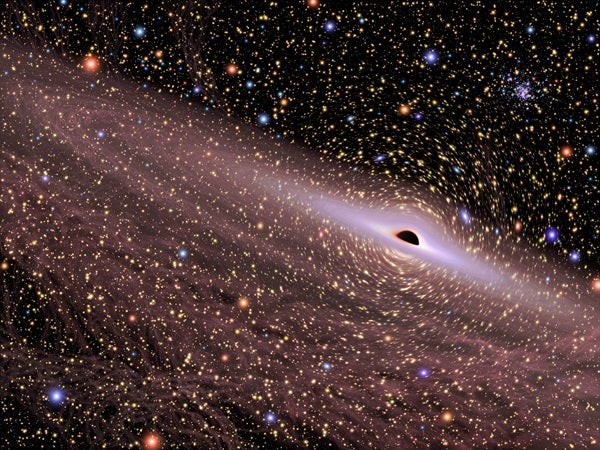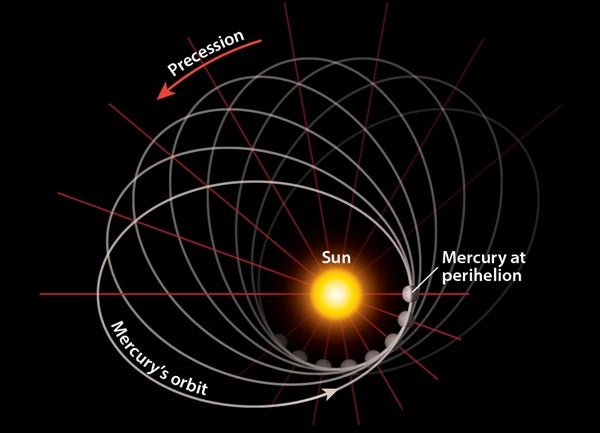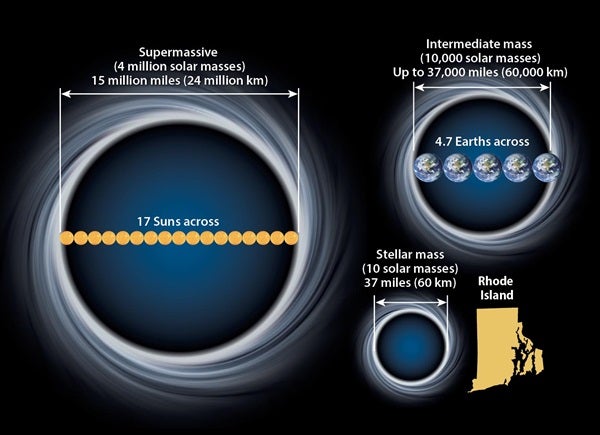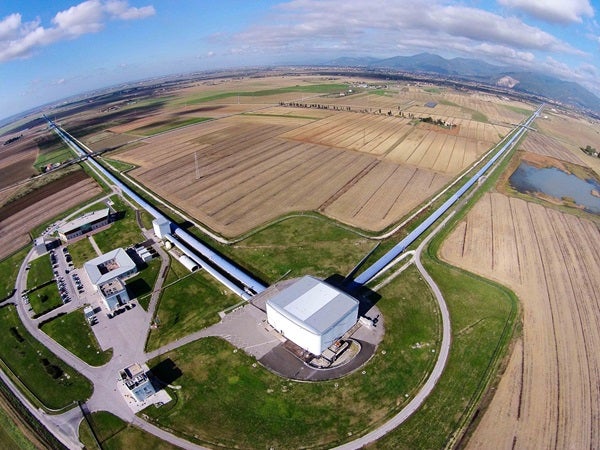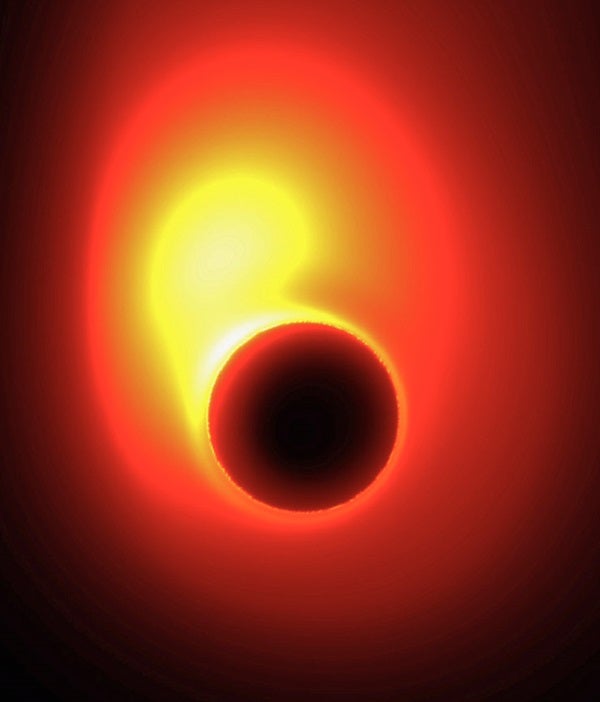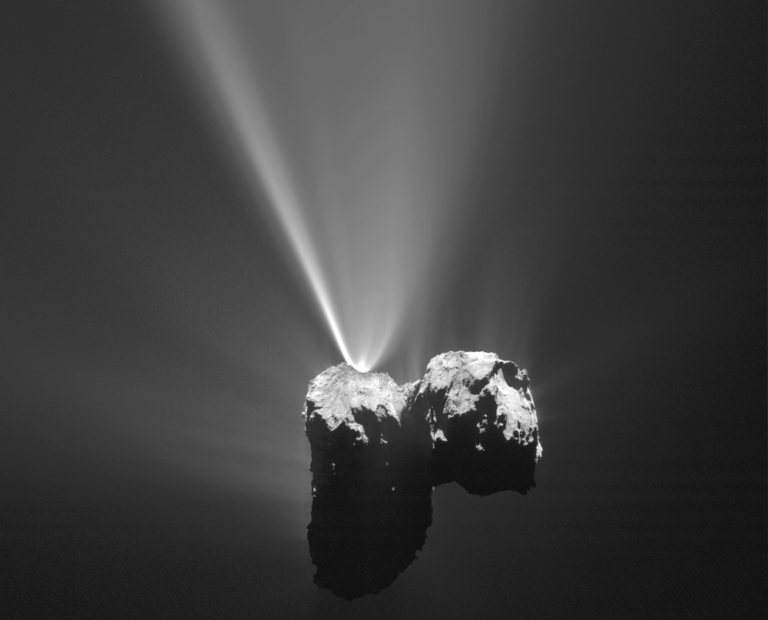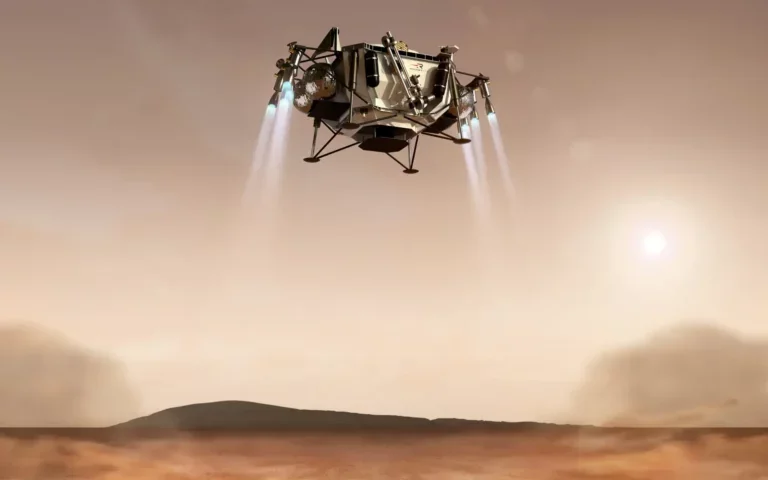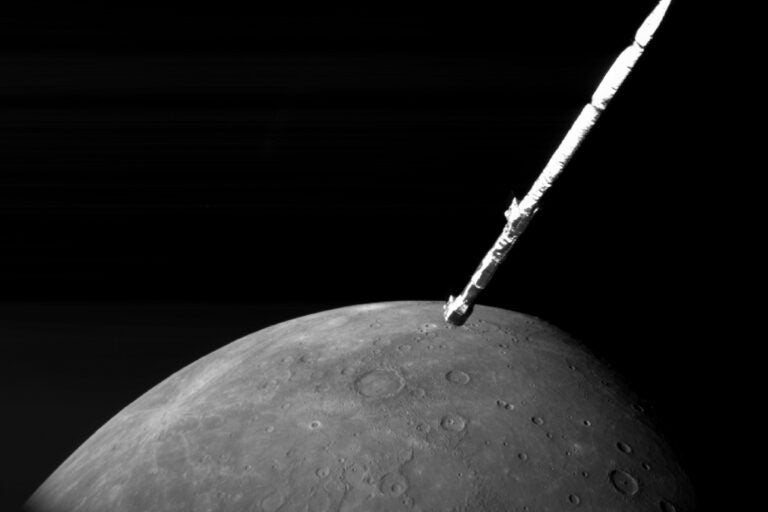It was a triumph for general relativity. But to physicists, it wasn’t an end; it was a beginning. Black holes — objects so dense that not even light can escape — proved Einstein right. Now, scientists want to use them to stretch relativity to its limits, and perhaps even break it.
“It’s not that we think relativity’s wrong,” says Andrea Ghez, a professor of physics and astronomy at the University of California, Los Angeles, and director of UCLA’s Galactic Center Group. “It’s just incomplete.”
Astronomers and physicists are working to probe black holes with radio telescopes and gravitational waves, as well as tracking the motions of stars and other matter around black holes to see if they follow the rules laid down by Einstein a century ago.
The general theory of relativity has passed every test physicists have devised so far. It underlies our understanding of space, time, and gravity; Global Positioning System satellites even take it into account. It superseded Isaac Newton’s conception of gravity as a force that acts instantaneously at a distance.
While the math in general relativity is more complex than in Newton’s gravity, its basic principles can be stated simply. Relativity treats gravity as a curvature in space-time. (Space-time itself merely adds time as a coordinate to the three normal space coordinates: length, width, and height.) An object bends the fabric of space-time, making a gravitational “well” at the location where a planet, star, black hole — or anything with mass — resides.
Meanwhile, light follows a curved path, bending around the edges of the well. An object with enough mass can behave like a lens, making objects behind it visible. And light traveling out of a gravity well is stretched, becoming redder as it climbs out. Time also slows as gravity gets stronger, so clocks near a black hole, a star, or even Earth’s surface will tick more slowly than those farther away.
Although relativity has passed every test with flying colors, gaps exist that have driven research for decades. A prime example is that Einstein’s gravity does not seem to fit into quantum mechanics, even though the three other fundamental forces of nature do. Each of the other three forces is mediated by particles: Photons carry the electromagnetic force, gluons carry the strong nuclear force, and W and Z bosons carry the weak nuclear force. But no one has yet observed the corresponding particle that should carry the gravitational force — the graviton — though current theories say it should exist.
Ghez says that some phenomena don’t quite fit into Einstein’s paradigm. Universal expansion is one. While it’s true that general relativity implies galaxies should be racing apart, the underlying reasons why cosmic expansion seems to be accelerating are still controversial. “Is that because we don’t have the right theory to describe gravity?” she asks. “Observationally, now we are just pushing the edges. We want a more complete version of gravity; there’s evidence this version isn’t good enough.”
Tim Johannsen, a postdoctoral fellow at the University of Waterloo in Ontario, studies gravity in extreme environments. He agrees that black holes may offer a way to find relativity’s breaking points. “There have been many experimental tests of general relativity, but hardly any of them have probed the strong-field regime in the immediate vicinity of a black hole so far,” he says.
The first tests involved the far weaker field surrounding the Sun. For example, the point in Mercury’s orbit where it comes closest to the Sun, called perihelion, advances about 2° per century. Relativity accounts for the tiny fraction, just 43″ per century, that Newton’s laws cannot. And observations of a total solar eclipse in 1919 found a small bending of light by the Sun’s gravitational field. Later, the discoveries of gravitational lensing and gravitational waves helped confirm relativity’s power to explain nature. It would seem that Einstein is in good shape, but the nagging question is whether his theory will hold up under more extreme conditions, or eventually show its incompleteness as Newton’s theory did.
Yet even with the knowledge that general relativity might not be the last word, any new theory still has to fit all the results that have come before. “The bar is getting higher,” says Nicholas Yunes, a physicist at Montana State University. “Whatever theory of gravity you decide to devise, at the very least it has to predict the same gravitational waves that [LIGO] observed.”
To make a black hole, you need to compress a lot of mass into a very small space. Einstein’s theory says it doesn’t matter what that mass is, but astronomers think nature makes stellar-mass black holes when massive stars die. All stars spend most of their lives fusing hydrogen into helium in their cores. The energy this produces creates an outward pressure that balances the inward pull of gravity. After a star exhausts its core hydrogen, it eventually starts to fuse helium into carbon.
More massive stars can tap into additional fuels. Ultimately, silicon fuses into iron and nickel. But the process stops there because fusing heavier elements consumes, rather than releases, energy. The star can no longer support its own weight with radiation pressure from fusion, so it collapses. The implosion triggers a shock wave that tears the star apart in a violent supernova explosion. For stars that begin life with more than 20 solar masses, the core left behind collapses to infinite density and becomes a singularity. An event horizon forms around the singularity, and you have a black hole.
The event horizon — the point of no return — is surprisingly small. The black hole at the center of the Milky Way Galaxy, known as Sagittarius A* (pronounced A-star), holds about 4 million times the Sun’s mass, but its event horizon is only 15 million miles (24 million kilometers) across. It would fit inside Mercury’s orbit with plenty of room to spare. A black hole with 10 times the Sun’s mass would have an event horizon that spans 37 miles (60 km) and would fit inside Rhode Island. And if Earth were compressed into a black hole, it would be the size of a marble. The event horizon radius increases in direct proportion to the black hole’s mass, but unlike Hollywood treatments, black holes don’t vacuum matter up. If an Earth-mass black hole replaced our planet, the Moon’s orbit wouldn’t change.
The small size matters because the gravitational field changes drastically as one approaches the event horizon. That’s why black holes are such good arenas for testing relativity. The gravity wells are steep — a person 3 feet (1 meter) from an Earth-mass black hole would feel a force more than 40 trillion times the gravity at Earth’s surface. In the vicinity of a black hole, the bending of light is easy to spot, and effects like time dilation and deviations from Newtonian mechanics are large enough to observe readily. If relativity stops working, then near a black hole is where we are likely to see it happen.
The hurried paths of stars
To track down some of these relativistic effects, Ghez’s research team is using a method similar to the one scientists used to analyze Mercury’s orbit. Sagittarius A* is the closest supermassive black hole, and astronomers can resolve individual stars orbiting it. One in particular, called S2, takes 16 years to complete its highly elliptical orbit. The black hole’s mass is why the star goes so fast. By the time it makes its closest approach to Sagittarius A* in mid-2018, at a distance about three times as far from the black hole as Pluto is from the Sun, it will be moving at between 1 and 2 percent the speed of light.
After years of observations, data from 2018 will give the researchers enough information to measure deviations from Newton’s laws due to general relativity accurately, Ghez says. Paradoxically,
the relativistic effects are so large they actually make it more difficult to do a Newton’s-law calculation.
“How do you convince yourself you know what Newton is predicting?” she says. Thus far, Einstein’s theory should show a difference from a Newtonian calculation of about 120 miles per second (200 km/s). Further deviations from that might show that Einstein’s theory is starting to fray.
The team’s observations also touch on another mystery, says Ghez. Stars near the galactic center should be relatively old. The clouds of gas and dust that would give birth to stars shouldn’t be stable so close to a supermassive black hole; calculations based on relativity show that tidal forces should disrupt them. Yet stars near the center skew young. Unless someone can invoke a mechanism for quickly getting these youngsters in from an outer region, they demonstrate that scientists must be missing something.
Johannsen is among the astronomers taking a different tack, using the Event Horizon Telescope (EHT) to see if relativity breaks down in the “shadow” of a black hole.
The EHT is a collection of radio telescopes spread around the world. Using a technique called very long baseline interferometry, the telescopes work together to achieve a resolution comparable to a single instrument with a diameter nearly as wide as our planet. The array delivers enough resolution for radio astronomers to observe the edges of Sagittarius A*, as well as the much larger supermassive black hole that lurks at the center of the giant elliptical galaxy M87 in the Virgo Cluster. Accretion disks of gas and dust surround both black holes. Such disks tend to form around black holes because their strong tidal forces rip apart any object that gets too close. Friction within the disk heats the material to millions of degrees before it falls into the hole, and the gas glows brightly in wavelengths ranging from X-rays to radio.
Since black holes act like lenses, Johannsen’s team expects to see a perfect ring of light as the photons from behind the black hole are bent around it. (Although most researchers describe the dark void at the center of the ring as a “shadow,” it is really a silhouette of the black hole against the bright background light.) If that ring isn’t a perfect circle and shows some oscillations, then a quantum effect may be happening. It would be the first time anyone has seen anything like it around a black hole.
“The shape of a given shadow is almost entirely determined by gravity alone and not by the particulars of the gas and dust that are swirling around the black hole,” says Johannsen. “Therefore, the detection of the shadow can potentially be a clean measurement of the underlying theory of gravity without many of the complications that come with those messy surroundings.”
General relativity says the shape of the shadow should be nearly circular with a fixed size. Other theories of gravity posit other shapes. “If we find any of those deviations, there are two possibilities: Either [general relativity] is not correct in the strong-field regime, or [general relativity] still holds but the object is not a black hole but some exotica. Either one would be quite a sensation.”
Riding the waves
Perhaps one of general relativity’s most famous predictions was gravitational waves. (While Einstein’s theory gave gravitational waves a sound mathematical basis, the concept was not unique to him: Henri Poincaré and Oliver Heaviside also floated the concept.) Einstein predicted that accelerating massive objects would cause space-time to ripple. The resulting waves would propagate at the speed of light and not at an infinite speed as Newton’s formulation of gravity predicted. As of March 2018, astronomers with the LIGO and Virgo collaborations have picked up unequivocal evidence for gravitational waves six times.
LIGO and Virgo are interferometers. A laser is fired at a beam splitter that sends the light down two perpendicular arms. Each of LIGO’s arms is 2.5 miles (4 km) long, while each Virgo arm extends 1.9 miles (3 km). The two beams bounce off mirrors at the end of the arms and return to the beam splitter, where they combine into a single beam before heading into a photodetector. If the two beams travel precisely the same distance before merging, they will either cancel each other out or reinforce each other, and the photodetector will either pick up nothing, or it will see light as bright as the original beam.
LIGO’s two detectors and Virgo’s one are designed so the photodetectors record nothing if the arms stay the same length. But if the beams travel a different distance — as one would expect if passing gravitational waves distorted space-time — then the photodetectors will record an interference pattern, and the merged beam will appear brighter or dimmer than the original one. The interferometers can detect changes in the lengths of their arms as small as 1/10,000 the width of a proton.
The detection of gravitational waves doesn’t mean Einstein’s theory can rest, however. In many ways, their detection raises as many questions as it answers. A few theorists have started to poke at the observations to see if they reveal hints at a quantum theory of gravity, or at least some connections that don’t violate quantum mechanics.
In late 2016, for example, researcher Jahed Abedi of the Sharif University of Technology in Tehran, along with Hannah Dykaar and Niayesh Afshordi of the University of Waterloo, proposed that “echoes” in the gravitational wave signal might indicate there were some tiny structures near the event horizons of the merging objects, pointing to physics beyond general relativity. The idea wasn’t met with a lot of enthusiasm from fellow scientists. In a set of back-and-forth papers, skeptics stated that they had reservations about the theoretical basis. The next question is whether these echoes will show up in future observations.
Gravitational waves also may reveal physics beyond relativity in other ways, notes Kent Yagi, a theoretical astrophysicist at the University of Virginia. One way is simply by constraining parameters like the mass of the graviton. If this particle has no mass, then gravitational waves should move at the speed of light, he says. A graviton with mass means that gravitational waves can’t, by definition, go that fast.
If the graviton has mass, it has to be quite small. “We can constrain it to no more than 10-20 eV [electron volt] with the first detection, but beyond that, we don’t know. Maybe it’s 10-23 eV,” says Yunes. (An electron volt is a common measure of energy in particle physics; scientists often use it as a unit of mass by dividing a particle’s energy by the speed of light squared, per Einstein’s famous equation, E=mc2.) But at a certain point, if there’s no mass detected, one has to wonder if it’s massless — or even exists.
Meanwhile, other scientists have taken a crack at looking for quantum effects at large scales using combinations of black holes and neutron stars. Neutron stars are the corpses of stars born with more than about eight times the Sun’s mass, but less than the 20 solar masses needed to make black holes. They have powerful magnetic fields, and some send focused beams of radio waves in our direction at regular intervals like a lighthouse beacon — pulsars.
John Estes of Long Island University and his colleagues have proposed using the precisely timed signals from a pulsar orbiting a black hole to probe the region near the event horizon. Since black holes bend light, the pulsar’s signal would be delayed by a discrete amount when the pulsar passes behind the black hole. If quantum effects are important, then that delay would change in ways general relativity cannot predict, and might even reveal something about how quantum mechanics works with relativity.
But there’s another reason to do these kinds of tests. It is far from clear that gravity — and thus general relativity — applies the same way at different scales. Leo Stein of Caltech notes that the physics one encounters near a supermassive black hole, like the one at the center of the Milky Way, might be different from the physics near a stellar-mass black hole.
LIGO, for example, showed us that gravitational waves are generated in the expected way near a stellar-mass black hole. The steepness of the curvature of space just outside the event horizon is smaller for larger black holes, however. “It’s potentially very different physics,” Stein says. “When curvatures are large, you need to use LIGO. When interested in physics on the millions-of-kilometers scale, there are things you might be able to test with the EHT. In the middle is stuff we have got nailed down, at the solar system scale.
“Cosmologists are interested in changing the theory of gravity at very large distance scales,” he says. “String theorists and high-energy physicists are changing the theory of gravity at the quantum level.”
As with many mysteries, however, we may have to wait for observations to tell us one way or the other which theory is correct. “The puzzle is getting completed one piece at a time,” says Yunes.

